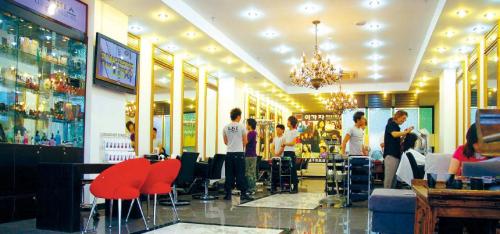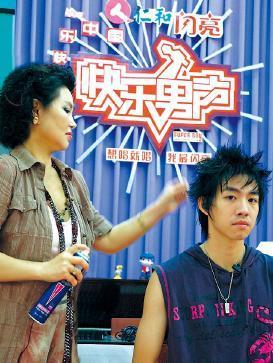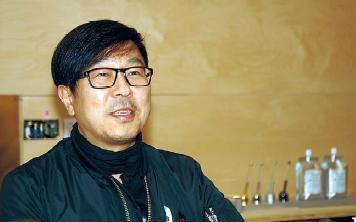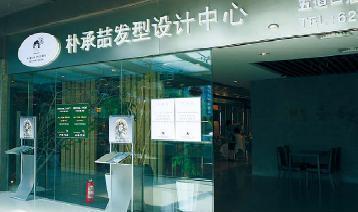The proliferation of Korean restaurant franchises in China has received plenty of media attention; hair salons, not so much.
When, in mid-April, the Korea Trade-Investment Promotion Agency and the Ministry of Knowledge Economy announced which 13 domestic franchise businesses they had decided to help go abroad, two hair salon companies stood out of the crowd.
Alongside eight dining businesses, Leechul Hairkerker and ParkSeungChol Hairstudio had made the cut. KOTRA and MKE would help the two launch stores in Shanghai over the course of a year.
When, in mid-April, the Korea Trade-Investment Promotion Agency and the Ministry of Knowledge Economy announced which 13 domestic franchise businesses they had decided to help go abroad, two hair salon companies stood out of the crowd.
Alongside eight dining businesses, Leechul Hairkerker and ParkSeungChol Hairstudio had made the cut. KOTRA and MKE would help the two launch stores in Shanghai over the course of a year.

What some people may not know is that not only do both Leechul and ParkSeungChol already have shops in Beijing, they are not alone.
Before ParkSeungChol and Leechul entered the market in 2007 and 2008, respectively, veteran hairdresser-and-CEO Lee Kaja opened a salon in the five-star Beijing Hotel nearly a decade ago.
To date, there are around 32 Leekaja Hairbis salons in eight Chinese provinces. Leechul has one, ParkSeungChol three. Leekaja is a major league player, whereas Leechul and ParkSeungChol are two minor leaguers on the rise.
So why are these three major companies looking toward China? If you think it is all about Hallyu, think again.
“For beauty (salons), I really don’t think that Hallyu, for instance coming into get Rain’s haircut, is really present,” Kerker CEO Lee Chul told The Korea Herald.
“Of course, Hallyu is there, but for us, I don’t think it really helped business.”
What then would give Korean hair salons in China a market advantage?
KOTRA China business department senior researcher Kim Myung-shin thinks it has to do with skills.
“The level of hairdressing techniques that Koreans possess has a considerable competitive edge on local (Chinese) territory,” Kim said in an e-mail interview. “You can see the frequent use of Korean beauty salons by high-income Chinese consumers as a result of good hairdressing skills rather than because they want to follow Korean celebrities’ hairstyles.”
Both Leekaja’s overseas business and marketing manager Lee Woo-chan, and ParkSeungChol’s director Joun Boum-soo agree that Korean hairdressers are highly skilled. But for both Leekaja and ParkSeungChol, Hallyu still plays a significant role.
“Hallyu is also pretty important,” said Leekaja manager Lee.
“When Chinese customers come to our stores, yes, it is because they want a Hallyu style,” said ParkSeungChol’s education department deputy head Do Jin-a.
If that is the case, then which Hallyu stars’ coifs are the most coveted?
Both Leekaja’s Lee and ParkSeungChol’s Do singled out Korean actor-and-singer Rain.
“Customers bring photos of Kim Tae-hee and Han Chae-young,” Lee added, before also mentioning actor Jang Dong-gun and K-pop groups like BIGBANG and 2NE1.
“Older clients like actress Kim Hee-ae,” said Do, who added that K-pop boy band Super Junior’s hair was in vogue at the moment.
But do not mistake the trends of these three salons as representative of the Chinese population. All three primarily cater to upper middle and upper class Chinese.
“If (a cut) is 300 yuan ($43.92) then it is not very expensive but it is not cheap, so we get clients that fit that price range,” said Lee Chul, who counts English-speaking Chinese people and office workers among his customers.
While Leechul targets upper middle class Chinese clientele, both Leekaja and ParkSeungChol tend to reel in high-income customers.
Before ParkSeungChol and Leechul entered the market in 2007 and 2008, respectively, veteran hairdresser-and-CEO Lee Kaja opened a salon in the five-star Beijing Hotel nearly a decade ago.
To date, there are around 32 Leekaja Hairbis salons in eight Chinese provinces. Leechul has one, ParkSeungChol three. Leekaja is a major league player, whereas Leechul and ParkSeungChol are two minor leaguers on the rise.
So why are these three major companies looking toward China? If you think it is all about Hallyu, think again.
“For beauty (salons), I really don’t think that Hallyu, for instance coming into get Rain’s haircut, is really present,” Kerker CEO Lee Chul told The Korea Herald.
“Of course, Hallyu is there, but for us, I don’t think it really helped business.”
What then would give Korean hair salons in China a market advantage?
KOTRA China business department senior researcher Kim Myung-shin thinks it has to do with skills.
“The level of hairdressing techniques that Koreans possess has a considerable competitive edge on local (Chinese) territory,” Kim said in an e-mail interview. “You can see the frequent use of Korean beauty salons by high-income Chinese consumers as a result of good hairdressing skills rather than because they want to follow Korean celebrities’ hairstyles.”
Both Leekaja’s overseas business and marketing manager Lee Woo-chan, and ParkSeungChol’s director Joun Boum-soo agree that Korean hairdressers are highly skilled. But for both Leekaja and ParkSeungChol, Hallyu still plays a significant role.
“Hallyu is also pretty important,” said Leekaja manager Lee.
“When Chinese customers come to our stores, yes, it is because they want a Hallyu style,” said ParkSeungChol’s education department deputy head Do Jin-a.
If that is the case, then which Hallyu stars’ coifs are the most coveted?
Both Leekaja’s Lee and ParkSeungChol’s Do singled out Korean actor-and-singer Rain.
“Customers bring photos of Kim Tae-hee and Han Chae-young,” Lee added, before also mentioning actor Jang Dong-gun and K-pop groups like BIGBANG and 2NE1.
“Older clients like actress Kim Hee-ae,” said Do, who added that K-pop boy band Super Junior’s hair was in vogue at the moment.
But do not mistake the trends of these three salons as representative of the Chinese population. All three primarily cater to upper middle and upper class Chinese.
“If (a cut) is 300 yuan ($43.92) then it is not very expensive but it is not cheap, so we get clients that fit that price range,” said Lee Chul, who counts English-speaking Chinese people and office workers among his customers.
While Leechul targets upper middle class Chinese clientele, both Leekaja and ParkSeungChol tend to reel in high-income customers.

“In the Beijing Hotel (salon), if you get a perm you need to pay about 600,000 won ($528),” said Leekaja’s Lee.
So how do Leekaja Hairbis’ customers pay for their hairdos?
They whip out a pre-paid card that can be worth 10,000 yuan ($1,464), for example, “then we give them 12,000 yuan ($1,756.94) worth of services.”
“In China there are lot of instances where service businesses do business with pre-paid cards,” said KOTRA’s Kim, who revealed that this method is commonly used to ensure loyal customers by giving them a discount through pre-paid cards.
“This sales method is often used in businesses like hair salons and massage spas,” Kim added.
What kind of pre-paid card is the most popular?
“They like gold colors,” said manager Lee. “That is why the gold color always has the highest value.”
“Gold is the emperor’s hue,” Kim explained.
Gold, however, is not the color that all three hair salons saw when they first entered the Chinese market. They saw red.
All three revealed that it took them anywhere from one to three years to bring in serious profits.
“After a year, we made some profit, a little,” said Lee Chul.
So how do Leekaja Hairbis’ customers pay for their hairdos?
They whip out a pre-paid card that can be worth 10,000 yuan ($1,464), for example, “then we give them 12,000 yuan ($1,756.94) worth of services.”
“In China there are lot of instances where service businesses do business with pre-paid cards,” said KOTRA’s Kim, who revealed that this method is commonly used to ensure loyal customers by giving them a discount through pre-paid cards.
“This sales method is often used in businesses like hair salons and massage spas,” Kim added.
What kind of pre-paid card is the most popular?
“They like gold colors,” said manager Lee. “That is why the gold color always has the highest value.”
“Gold is the emperor’s hue,” Kim explained.
Gold, however, is not the color that all three hair salons saw when they first entered the Chinese market. They saw red.
All three revealed that it took them anywhere from one to three years to bring in serious profits.
“After a year, we made some profit, a little,” said Lee Chul.

It took Leekaja Hairbis’ first shop, says manager Lee, three to four years to break even.
“We need money to cover the costs for the year,” said Leekaja’s Lee, who added that they tell franchisees that it takes time to build up business and therefore they need to have enough money.
“For a hair salon that first opens, a certain amount of time will be needed for it to get settled,” said KOTRA’s Kim. “Two to three years are needed for other businesses, not just hair salons, to break even when they enter China.”
Once you make it, says Lee Kaja’s Lee, it is all fairly easy.
“In China, once it is settled, it is pretty easy and fast,” said Lee, revealing plans to open about 1,000 more salons in China over the next five years.
Settling, in part, seems to rely primarily on word-of-mouth.
“When Chinese consumers make a purchasing decision they think that advice and evaluations from friends or people around them are more trustworthy than advertisements. Because of that, word-of-mouth marketing is important in China,” said KOTRA’s Kim.
“If a customer ends up liking the results then they tend to introduce the place to many other people around them,” said Lee Chul.
For the time being, however, it looks like these Korean hair salons are currently limited to a niche market, and it is one that they are looking to break out of.
Leekaja’s Lee revealed plans to “downgrade their target market” and continue expansion.
“We need money to cover the costs for the year,” said Leekaja’s Lee, who added that they tell franchisees that it takes time to build up business and therefore they need to have enough money.
“For a hair salon that first opens, a certain amount of time will be needed for it to get settled,” said KOTRA’s Kim. “Two to three years are needed for other businesses, not just hair salons, to break even when they enter China.”
Once you make it, says Lee Kaja’s Lee, it is all fairly easy.
“In China, once it is settled, it is pretty easy and fast,” said Lee, revealing plans to open about 1,000 more salons in China over the next five years.
Settling, in part, seems to rely primarily on word-of-mouth.
“When Chinese consumers make a purchasing decision they think that advice and evaluations from friends or people around them are more trustworthy than advertisements. Because of that, word-of-mouth marketing is important in China,” said KOTRA’s Kim.
“If a customer ends up liking the results then they tend to introduce the place to many other people around them,” said Lee Chul.
For the time being, however, it looks like these Korean hair salons are currently limited to a niche market, and it is one that they are looking to break out of.
Leekaja’s Lee revealed plans to “downgrade their target market” and continue expansion.

Lee Chul divulged a desire to start a franchise under the moniker Hair Kerker, leaving his current Beijing direct salon and his future Shanghai direct salon under the name Leechul Hairkerker.
Meanwhile, according to director Joun, ParkSeungChol also currently operates salons in Beijing and is looking into what they call the “master franchise” business.
For now, all three have their sights set on Shanghai.
Director Joun explained his company’s current fascination with China’s most-populated metropolis: “Business-wise, Shanghai is the biggest city (in China).”
By Jean Oh (oh_jean@heraldcorp.com)
Meanwhile, according to director Joun, ParkSeungChol also currently operates salons in Beijing and is looking into what they call the “master franchise” business.
For now, all three have their sights set on Shanghai.
Director Joun explained his company’s current fascination with China’s most-populated metropolis: “Business-wise, Shanghai is the biggest city (in China).”
By Jean Oh (oh_jean@heraldcorp.com)


![[Exclusive] Korean military set to ban iPhones over 'security' concerns](http://res.heraldm.com/phpwas/restmb_idxmake.php?idx=644&simg=/content/image/2024/04/23/20240423050599_0.jpg&u=20240423183955)




![[Pressure points] Leggings in public: Fashion statement or social faux pas?](http://res.heraldm.com/phpwas/restmb_idxmake.php?idx=644&simg=/content/image/2024/04/23/20240423050669_0.jpg&u=)

![[Herald Interview] 'Amid aging population, Korea to invite more young professionals from overseas'](http://res.heraldm.com/phpwas/restmb_idxmake.php?idx=644&simg=/content/image/2024/04/24/20240424050844_0.jpg&u=20240424200058)








